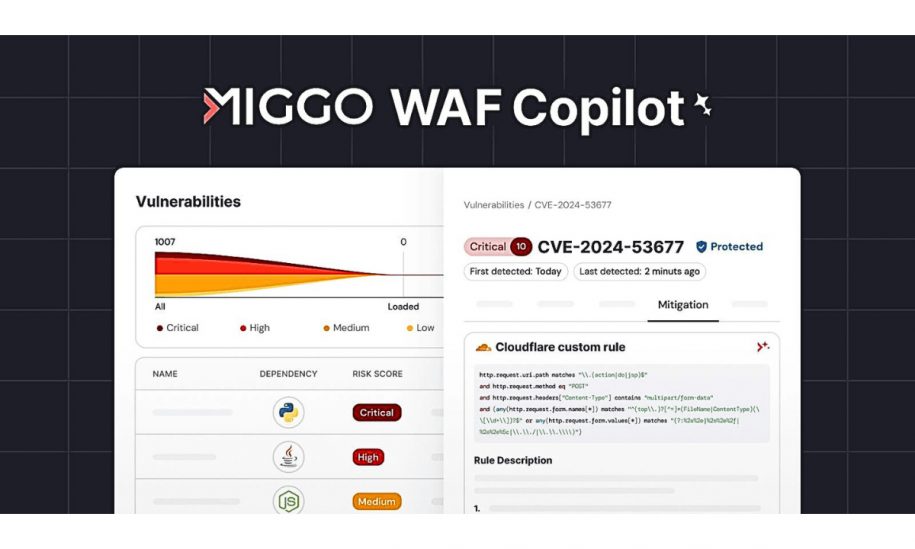New York, United States, August 4th, 2025, FinanceWire
Vulnerabilities don’t come with a grace period anymore. The moment they’re disclosed publicly or privately, they’re already being scanned, exploited, and weaponized. According to the latest threat intelligence, critical flaws are often attacked within 15 minutes of disclosure. That puts security teams in an impossible situation: They can see the danger but can’t patch fast enough to prevent damage.
This is the high-stakes problem Miggo Security is solving with Miggo WAF Copilot, a first-of-its-kind solution that enables instant defense using the WAF you already have.
“Miggo WAF Copilot transforms the traditional WAF technology so that security teams can easily maximize their WAF to be a super-effective, proactive, and powerful mitigative control,” said Daniel Shechter, CEO and Co-founder of Miggo Security.
Traditional WAFs Aren’t Enough
Web Application Firewalls were designed to be a frontline defense, but too often, they’re deployed with generic rules that block known attacks, not emerging ones. They lack insight into application logic, and they’re notoriously difficult to manage and tune, especially in fast-moving production environments.
That’s where Miggo WAF Copilot comes in. Instead of relying on static defenses, it adds intelligence, automation, and speed to the WAF. When a new vulnerability hits the radar, Copilot doesn’t wait; it acts.
Here’s How It Works
When a new vulnerability is detected, either through public disclosure, threat intel feeds, or internal alerts, Miggo WAF Copilot automatically begins scanning multiple data sources, including code repositories, known exploits, and security research. It then generates different payload variants to simulate how a real attacker might exploit the vulnerability.
From there, the system performs a deep root cause analysis to determine exactly how the vulnerability can be triggered in the context of a live application. It uses this information to generate a precise WAF rule tailored to the specific vulnerability, not just the CVE.
“Miggo WAF Copilot delivers unmatched precision,” said Itai Goldman, Co-founder and CTO at Miggo Security. “It doesn’t just block broad attack patterns — it neutralizes the exact threat, keeping uptime and performance intact.” This precision instills confidence in the system’s ability to protect your applications.
Seamless Rule Deployment, Zero Downtime
The custom WAF rule generated by Miggo Copilot is first deployed in log mode, ensuring it doesn’t impact legitimate traffic. Once validated, teams are notified that it’s safe to activate full blocking mode. Miggo continues to monitor traffic, validate effectiveness, and recommend when to retire the rule once the vulnerability is fully patched, closing the remediation loop.
The platform is compatible with leading WAF providers, including Cloudflare, AWS, Azure, GCP, Akamai, F5, Fortinet, and Imperva. That means security teams don’t need to rip and replace anything. They just plug in Miggo WAF Copilot and instantly enhance their existing setup.
From Passive Risk Awareness to Proactive Protection
For years, security teams have been expected to defend modern applications with outdated, reactive tools. Now, they can turn their WAF into a smart, self-adapting security layer that acts the moment a threat emerges. With over 90% reduction in time to exposure, Miggo WAF Copilot brings production-grade protection online in minutes, not days.
It’s not just about blocking attacks, but also enabling security teams to operate at the speed of AI-driven threats. “WAFs are powerful tools,” said Shechter. “But they must evolve.”
Miggo WAF Copilot is now available. Organizations ready to close the gap between vulnerability discovery and real protection can visit the Miggo website to learn more or request access.
About Miggo
Miggo’s mission is bold yet precise: Secure every application, everywhere. It fills a critical blind spot in traditional security approaches by delivering runtime visibility and protection deep inside applications, at the function level, rather than relying solely on network or host monitoring

